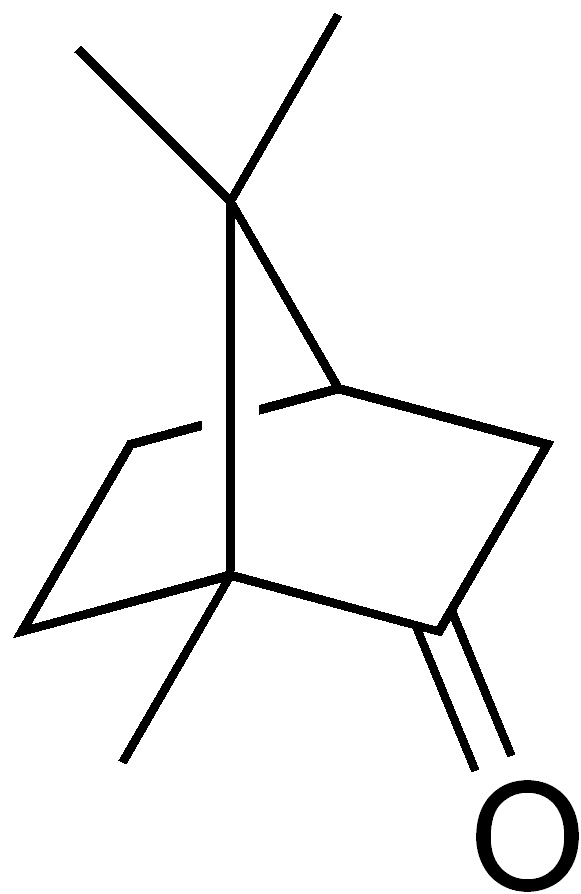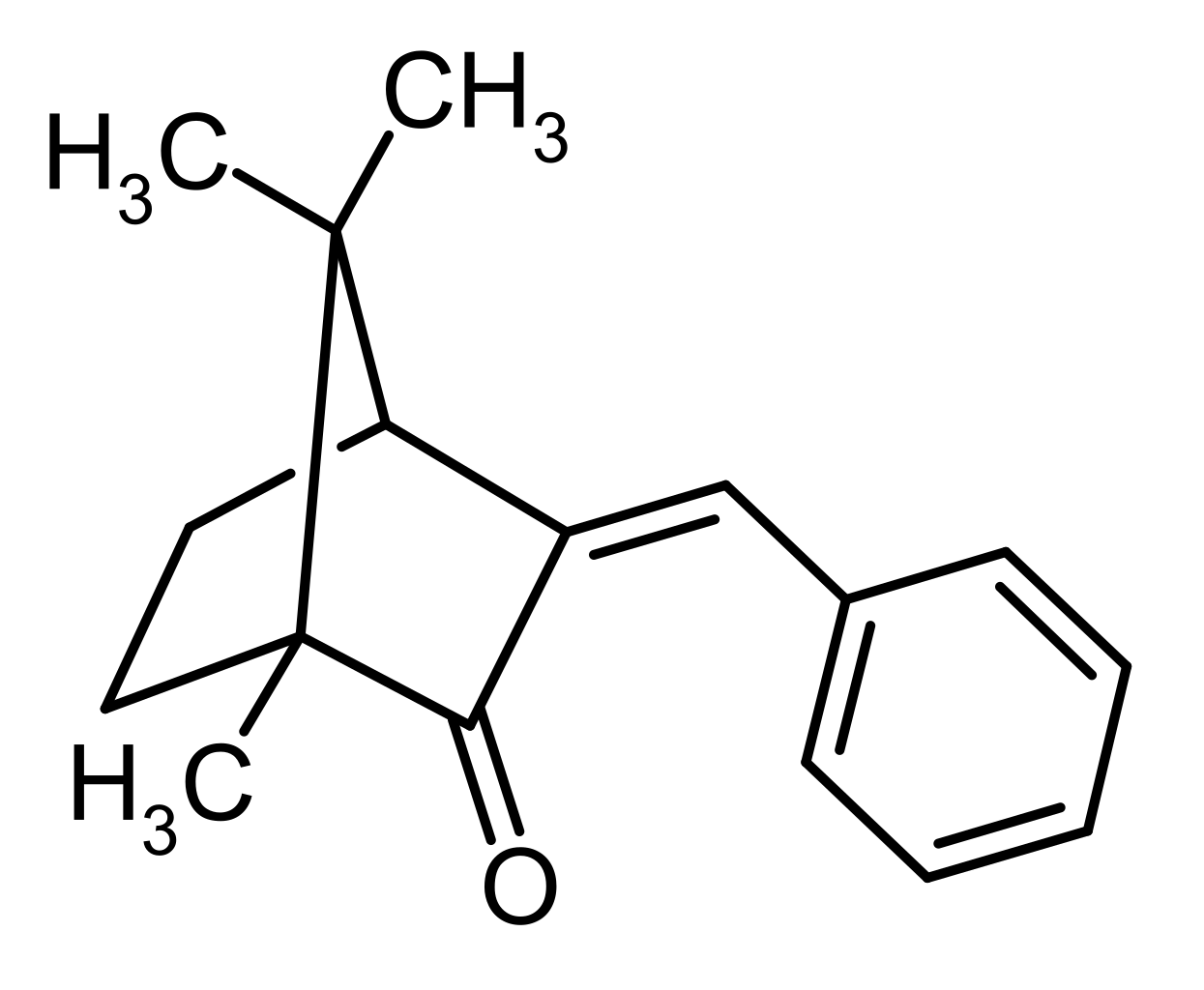|
Size: 12425
Comment:
|
Size: 12417
Comment:
|
| Deletions are marked like this. | Additions are marked like this. |
| Line 35: | Line 35: |
| Line 36: | Line 37: |
| Line 40: | Line 39: |
| Line 43: | Line 40: |
| ||[[attachment:3-Benzylidene_camphor_structure.svg.png|{{attachment:3-Benzylidene_camphor_structure.svg.png|3-Benzylidene|width="300"}}]] || | |
| Line 46: | Line 42: |
| ||[[attachment:3-Benzylidene_camphor_structure.svg.png|{{attachment:3-Benzylidene_camphor_structure.svg.png|3-Benzylidene|width="300"}}]] || | |
| Line 47: | Line 44: |
| Line 82: | Line 76: |
| '''Text Books ''' | === Text Books === |
| Line 86: | Line 80: |
| '''Websites ''' | === Websites === |
| Line 90: | Line 84: |
| ''' Scientific Articles ''' | === Scientific Articles === |
| Line 104: | Line 98: |
| '''Figure References''' | === Figure References === |
Camphor: An Endocrine Disruptor
Introduction
Chemicals that interfere with hormone systems in animals and humans are called endocrine disruptors. These chemicals are capable of adversely affecting the hormone balance and embryo development of organisms and their offspring. [1]
Camphor is one of these chemicals, it is a waxy, flammable, transparent solid with a strong aroma. It has the chemical formula C10H16O. Naturally occurring camphor is found in the fragrant camphor tree (Cinnamomum camphora) and it can also be artificially-made. It is used in UV sunscreens as 4-methylbenzylidene camphor C18H22O, the endocrine disruptive effects of camphor in these products has a weak estrogenic action and can alter sexual behaviour. [2]
Camphor
Figure 5 : Camphor |
Importance of Camphor
Camphor is widely used in sunscreens and other cosmetic products as a UV-filter. Human exposure to UV filters is influenced by many factors: geographic location, season, lifestyle, gender or occupation, this results in high individualization. For instance, a study in Australia showed 56% of people apply sunscreens at least 5 days per week, and 27% of people apply sunscreen two days or less a week.[5] In another study of 32 healthy volunteers, UV-filters were detected in the blood plasma after two hours and in urine samples after 24 hours from first application. [4] UV-filters, which are topically applied and absorbed through the skin, have been found in 96% of urine samples in the US and 85% of Swiss breast-milk samples. [3]
The most relevant entry route of chemicals related to sunscreen use is dermal exposure, however considering common human behaviour related to sunscreen application, e.g. eating and drinking after applying sunscreen, gastrointestinal or pulmonary exposure should also be considered.[6] This shows a correlation between the increased use of the substance resulting in increased ingestion/absorption and therefore the increased possibility for adverse effects to occur. 4-MBC exhibits a toxic activity as oestrogenic endocrine disruptor.[6]
Physiological effects of Camphor and its derivatives
In sunscreen and other cosmetic products, 4-methylbenzylidene camphor (4-MBC), is an organic camphor derivative used as a UVB filter. However other countries allow its usage at maximum concentration of 4%, the compound is not approved by the Food and Drug Administration (FDA). 4-MBC is a high lipophilic compound which can be absorbed through the skin and has been found in human tissues, including placenta.[6]
3-benzylidene camphor 3-benzylidene camphor (3-BC) is closely related to 4-methylbenzilidene camphor and it is a lipophilic compound. In the EU it is used in sunscreens, with a maximal concentration of 2%. After 65 days of topical application to rats 3-BC was detected in all analysed tissues, including the brain, this suggests that in humans similar disposition and distribution may occur. In the urine of Danish children, the compound was not detected but the compound was found in human placenta. 3-BC has also been described as an estrogenic disruptor. Reports indicate that 3-BC can affect the CNS. Rats showed region- and sex-specific response in expression of genes involved in sexual behavior: PR, estrogen receptors (ERa, ERb), and steroid receptor coactivator-1 (SRC-1) in the brain when treated pre- and postnatally with 3-BC [6].
Large quantities of in vitro and in vivo animal studies have shown that the UV-filters present in sunscreens and cosmetics have a large number of potential adverse effects. These adverse effects include developmental and reproductive effects, caused by the endocrine disrupting actions of these chemicals. Some other studies could not find such adverse effects.
However, as many well-designed studies have shown the wide human exposure and the clear endocrine disruptive effects, these substances can be considered as substances of high concern in relation to human risk. Most of the studies regarding the adverse effects of UV‐filters have been evaluated after oral exposure. However, the primary exposure of humans is through dermal application via cosmetics. UV‐filters enter the body without being metabolised by the liver, this leads to a greater risk of the unaltered compounds reaching tissues of the whole body through the systemic circulation [7].
This was observed in rats following dermal exposure to 3‐BC. After topical application compared with oral exposure, a three‐fold greater oestrogenic effect of 4‐MBC was observed in rats, indicating higher fraction of an administered dose of the compound [8].
Reports have shown 4-MBC to have an acetylcholinesterase (AChE) inhibitory activity. Zebrafish embryos showed abnormal axial curvature and exhibited impaired motility when exposed to 15 μM 4-MBC for 3 days. When exposed to 10 and 100 μM for 45 min, inhibition of AChE activity has also been observed in mammalian Neuro-2a cells, induced muscular and neuronal defects indicate a possible mechanism for the 4-MBC. 4-MBC (up to 100 μM) suggest possible neurotoxic effects, a study had recently shown 4-MBC to decrease cell viability and induce apoptosis in neuroblastoma cell line (SH-SY5Y), however , in vivo, effective concentrations were not observed.[6]
Rats exposed to 4-MBC (7–47 mg/kg) in their diet before mating, during pregnancy and lactation, showed a region- and sex-dependent alteration in the oestrogenic genes in the brain, this also manifested in their offspring until adulthood when 4-MBC was introduced into their diet. After 4-MBC exposure, females showed impaired proceptive and a non-receptive sexual behavior. At the lowest doses studied (7 mg/kg/day), female sexual behaviour was significantly impaired, this resulted in a concentration of 208.6 ng/g lipid in rat milk, which is over 10 times higher value than found in human milk 19 ng/g lipid.[6]
Disrupting Effects toward Oestrogen Receptor (ER)
Fish, mammals and cell-based bioassay studies have shown that anti estrogenic activity is exhibited by 4-MBC and 3-BC. During early development and postnatal life rats exposed to 3-BC could show significant changes in the expression of ERs and oestrogen target genes. In immature rats 3-BC exhibited estrogenic potency and also showed high estrogenic potency of inducing Vitellogenin (VTG) in juvenile fathead minnow. The sex ratio of the frog Xenopus laevis was negatively affected by 4-MBC and 3-BC. [7]
Disrupting Effects toward Androgen Receptor (AR)
No agonistic activation was shown by 4-MBC and 3-BC toward ARs. In a concentration-dependent mode they could inhibit the activity of ARs. This was revealed by the recombinant yeast assays. 4-MBC significantly inhibited luciferase activity and was proved to be a potent human AR antagonist. Testosterone formation was prevented by 4-MBC and 3-BC also concentration-dependently inhibited androgen-metabolizing 17β-HSD3 in HEK-293 cells. [7]
Disrupting Effects toward Progesterone Receptor (PR)
4-MBC developmental exposure could cause PR mRNA levels in male medial preoptic area to increase, in female rats this was not detected. At very low doses 4-MBC the expression level of PR protein can be down-regulated. Increasing the doses normal or slightly supra-normal levels of expression of PR protein returned. At different developmental stages changes in mRNA was measured, 4-MBC disturbed the expression of membrane-associate PR. 4-MBC and 3-BC showed no PR. At low concentrations these two UV filters were antagonists of PR [7]. Progesterone receptor (PR) expression, in 4-MBC treated females, was decreased in the ventromedial hypothalamic area, but not in males. [6]
Conclusion
After reading and studying these reports, it is definitely of concern that the endocrine disrupting effects of UV-filters, found in sunscreen, have been shown in a large number of in vitro and in vivo animal studies. This is substantiated by the application of cosmetics with UV‐filters, to the skin, in a noticeably increasing amount, on a day to day basis. This increase can result in absorption of UV‐filters into the human systemic circulation at an alarming rate and subsequently may expose all tissues in the body to these UV-filters and their endocrine disrupting effects, leading to dramatic changes in the physiology of us as humans.
The careless discarding of these chemicals into the ecosystem, will lead to widespread exposure to nature. As studies have shown, animals will also be greatly affected by these man-made substances, their physiology can be adversely altered, and we can disrupt their equilibrium, resulting in all forms of defects, physiologically, physically, and even affect their breeding abilities. UV-filters were assumed to protect against the increased incidence of malignant melanoma, and this promoted the use of sunscreen. We have now seen that this might not be the case. Considering all these facts talked about above, together with the widespread and increasing use of sunscreens and cosmetics in everyday use, it seems relevant to investigate whether sunscreen use is beneficial for human health, specifically UV-filters.
References
Text Books
[1] Mozo, D. R. (2012) Endocrine Disrupters-Solutions to new challenges. Instituto Sindical de Trabajo, Ambiente y Salud
Websites
[2] National Center for Biotechnology Information. PubChem Database. 4-Methylbenzylidene camphor, CID=6440721, https://pubchem.ncbi.nlm.nih.gov/compound/6440721
Scientific Articles
[3] Krause, M.; Klit, A.; Blomberg, M. J.; Søeborg, T.; Frederiksen, H.; Schlumpf, M.; Lichtensteiger, W.; Skakkebaek, N. E.; Drzewiecki, K. T. (2012): Sunscreens: Are they beneficial for health? An overview of endocrine disrupting properties of UV-filters. International Journal of Andrology 35: (3) 424-236
[4] Janjua, N. R.; Kongshoj, B.; Andersson, A. M.; Wulf, H. C. (2008): Sunscreens in human plasma and urine after repeated whole-body topical application. The Journal of the European Academy of Dermatology and Venereology 22: (4) 456-461
[5] Neale, R.; Williams, G.; Green, A. (2002): Application patterns among participants randomized to daily sunscreen use in a skin cancer prevention trial. Archives of Dermatology 138: 1319-1325
[6] Ruszkiewicza, J. A.; Pinkasa, A.; Ferrera, B.; Peresa T. V.; Tsatsakisb, A.; Aschnera, M. (2017): Neurotoxic effect of active ingredients in sunscreen products, a contemporary review. Toxicology Reports 4: 245-259
[7] Wang, J.; Pan, L.; Wu, S.; Lu, L.; Xu, J.; Zhu, Y.; Guo, M.; Zhuang, S. (2016): Recent Advances on Endocrine Disrupting Effects of UV Filters. International Journal of Environmental Research 13: 782-793
[8] Søeborg, T.; Ganderup, N. C.; Kristensen, J. H.; Bjerregaard, P.; Pedersen, K. L.; Bollen, P.; Hansen, S. H.; Halling-Sørensen, B. (2006): Distribution of the UV filter 3-benzylidene camphor in rat following topical application. Journal of Chromatography. 834: 117–121.






